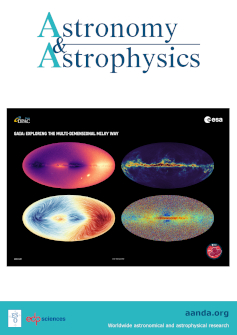C/2013 X1彗星(PANSTARRS)的尘埃特性及其变化
IF 5.4
2区 物理与天体物理
Q1 ASTRONOMY & ASTROPHYSICS
引用次数: 0
摘要
背景。我们分析了2015年12月至2016年1月期间在B、V和R约翰逊-考辛斯滤光片内获得的C/2013 X1彗星(PANSTARRS)的测光监测结果。主要目的是研究尘埃彗星并获得其尘埃粒子的物理特征。我们利用模型聚合的碎片颗粒对观测结果进行了分析,并对彗星C/2013 X1 (PANSTARRS)爆发前和爆发后的尘埃微物理特性进行了约束。此外,我们还对数字滤波器处理过的图像应用了几何模型,以估算彗核的旋转周期。我们的研究发现,2016 年 1 月 1 日彗星亮度急剧上升。在 17000 千米的孔径范围内计算出的 B - V 和 V - R 颜色似乎大多为红色,爆发日期除外。与2015年12月相比,1月2日的尘埃产生量(A f ρ代理)和归一化光谱梯度S′(B - R)发生了巨大变化。根据这一模型,按体积计算,C/2013 X1彗星彗尾由70%的有机物质粒子和两种类型的硅酸盐粒子共同构成,分别占另外的30%。其中一种硅酸盐颗粒由富含镁的硅酸盐组成,而另一种则由富含镁和贫铁的硅酸盐组成。我们用两个喷流结构来解释观测到的彗星形态,一个结构是由纬度为(85+5-3)°的近极活动区形成的,另一个结构是由纬度为(+40±5)°的活动区形成的。本文章由计算机程序翻译,如有差异,请以英文原文为准。
Dust properties and their variations in comet C/2013 X1 (PANSTARRS)
Context. We analyze the results of photometric monitoring of comet C/2013 X1 (PANSTARRS) from December 2015 until January 2016 obtained within B, V, and R Johnson–Cousins filters.Aims. The main objective is to investigate the dust coma and to obtain the physical characteristics of its dust particles.Methods. We analyzed our observations using model-agglomerated debris particles, and we constrained the microphysical properties of the dust in comet C/2013 X1 (PANSTARRS) on the pre-outburst and post-outburst epochs. Moreover, we applied a geometrical model to the images processed by digital filters to estimate the rotational period of the nucleus.Results. Our campaign revealed a sharp increase in the comet brightness on January 1, 2016. The B − V and V − R colors calculated within an aperture size of 17 000 km appear to be mostly red, except for the outburst date. The dust production (A f ρ proxy) and normalized spectral gradient S′ (B − R) dramatically changed on January 2 as compared to what was seen in December 2015. According to this model, the C/2013 X1 coma was populated by 70% organic-matter particles by volume and by two types of silicate particles together, constituting the other 30%. One type of silicate particles was composed of Mg-rich silicates, whereas the other type was composed of both Mg-rich and Fe-poor silicates. Using the geometrical model, we estimate the nucleus rotational period to be (24.02 ± 0.02) h. We interpret the observed coma morphology by two jet structures, one structure that formed by the near-pole active area at a latitude of (85+5−3)°, and the other structure formed by an active area at a latitude of (+40 ± 5)°.
求助全文
通过发布文献求助,成功后即可免费获取论文全文。
去求助
来源期刊

Astronomy & Astrophysics
地学天文-天文与天体物理
CiteScore
10.20
自引率
27.70%
发文量
2105
审稿时长
1-2 weeks
期刊介绍:
Astronomy & Astrophysics is an international Journal that publishes papers on all aspects of astronomy and astrophysics (theoretical, observational, and instrumental) independently of the techniques used to obtain the results.
 求助内容:
求助内容: 应助结果提醒方式:
应助结果提醒方式:


